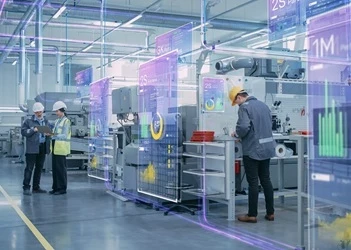When I was asked to talk about Intelligent Automation at IA Week 2018, I thought that the best approach was to assume the 'intelligent' bit referred to the people putting automation to work.
As conference chair, Kateryna Levchuk, said, our understanding of the world is coming on leaps and bounds. As we understand more about how we can use computers, we move closer to the great, distant promise of being able to lay on the beach and have a good time while the machines do all the work.
Kateryna herself admitted that an abundance of leisure time isn't the great barometer of human happiness - yet, anyway - when she observed that the unemployment rate in Poland is among the lowest in Europe, thanks to drastic 'shock therapy' measures taken to deal with the problem in the 1990s.
I always listen to as many other speakers as I can to make sure that I'm on-message, without necessarily repeating what others have said. I spotted that someone else had used exactly the same stock photo of a robot as I had in my presentation, but the content itself was, thankfully, different without being wildly off topic.
Kateryna's observation that AI working through data to solve problems meant 'we don’t have to play Sherlock Holmes and find out where the inefficiencies are... AI will point us directly to the bottleneck.' The intelligence here is squarely in the hands (or heads) of the person running the machines, not the machines themselves.
James Merrick-Potter from the Cabinet Office is responsible for accelerating RPA in government. His advice for starting RPA projects - start small, think big, be selective about the projects you undertake - again point to the importance of the person in charge being, well, a person. And both James and Iain Hennessey of Alder Hey Hospital spoke about their challenges at implementing a technology project in a culture that doesn't necessarily embrace change. James's colleagues wield political power, whilst Iain's are among the cleverest in the world, literally entrusted with the lives of other people. So how do you make the shift?
It was an issue I tackled in my presentation after lunch.
In this diagram I charted out how new technology provides consistent value over time (dipping off eventually). New technology may be expensive but eventually having the new technology provides more value than the legacy. At this cross over point, people move from being old fashioned and into the 'luddite' camp.
So what's the factor that makes people jump early?
I suggested that it was knowledge. Some of us love to learn and some of us love to learn from others. The red line on this graph shows how there's a 'sweet spot' where the potential of a new technology is realised before it is able to fully deliver.
Choosing the right moment to change is critical. the illustration I picked was Robert Falcon Scott using tractors - the Mars landers of their day - as part of his failed expedition to be the first team to reach the South Pole.
A later mission, led by Ernest Shackleton in 1914, took dogs (legacy technology). Scott's men died on their return journey; Shackleton didn't lose a single crew member (including a boy scout and a stowaway) despite being stuck in the ice for 19 months. The dogs provided more warmth, companionship, entertainment and food than Scott's expensive tractor.
I think we were all moved by Iain Hennessey's stories from the wards of Alder Hey. I was struck by how different people approach the problem of healthcare; for some it's a puzzle (how do we diagnose this?) for patients it's a minefield of emotions (I'll never forget Iain's story of the girl who believed - wrongly - that she'd never be able to have children), and parents have to face the possibility of losing a child. I hope that I did justice to the idea that there are many different ways of looking at a problem, and that unique human difference is something we should celebrate more even while we're busy standardising our processes and getting robots to work hard at finding all the 'right' answers for us.
Citing some of history's 'hidden figures' - Émilie du Châtelet, Ada Lovelace and Dorothy Vaughan being just three women who made major contributions in STEM subjects - I made the point that we should be making a bigger effort to talk to people with different lived experiences, and was pleased to have a conversation afterwards with a woman in a tech role who commented that the gender mix at IA Week, while not 50:50, was a lot better than some conferences she'd attended recently.
We're human beings, we have lots of questions that don't have 'right' answers. While we can and should find jobs for the bots to do, we should also make sure we're finding plenty of work for the humans too.
All of which takes us back to Kateryna ‘s Polish economic miracle.
Making a speech isn't about the fifteen minutes I spend on stage, it's about the research that goes in at the front end, the support I get from my colleagues throughout the process, and the questions that come out afterwards. So if you saw the speech, or want to discuss the issues raised, please do head over to LinkedIn and make use of the comments section.





















